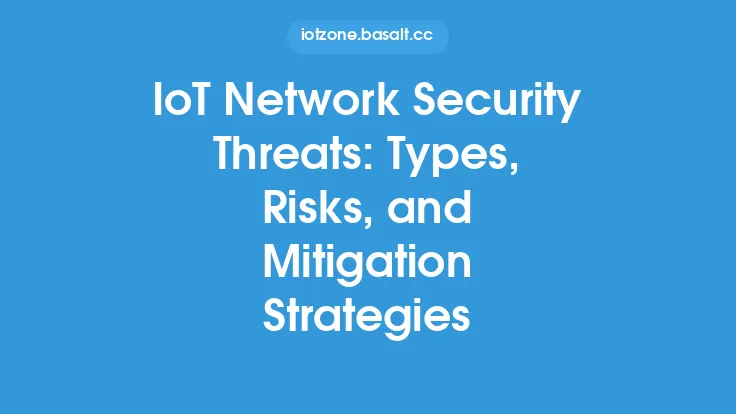The increasing number of devices connected to the internet has led to a rise in security concerns, particularly in the realm of the Internet of Things (IoT). As more devices become interconnected, the potential for vulnerabilities and threats grows exponentially. IoT network security is a critical aspect of ensuring the integrity and reliability of these connected devices, and it is essential to understand the threats, risks, and countermeasures associated with IoT networks.
Introduction to IoT Network Security
IoT network security refers to the practices and protocols used to protect IoT devices and networks from unauthorized access, use, disclosure, disruption, modification, or destruction. This includes securing the communication between devices, as well as the data that is transmitted and stored. IoT network security is a complex and multifaceted field, as it involves securing a wide range of devices, from simple sensors to complex systems, and protecting against various types of threats, including hacking, malware, and denial-of-service (DoS) attacks.
Threats to IoT Network Security
There are several types of threats to IoT network security, including:
- Device vulnerabilities: Many IoT devices have vulnerabilities that can be exploited by hackers, such as weak passwords, outdated software, and poor encryption.
- Network vulnerabilities: IoT networks can be vulnerable to attacks, such as man-in-the-middle (MitM) attacks, eavesdropping, and DoS attacks.
- Data breaches: IoT devices often collect and transmit sensitive data, which can be compromised if the device or network is not properly secured.
- Malware and ransomware: IoT devices can be infected with malware and ransomware, which can compromise the device and the network.
- DDoS attacks: IoT devices can be used to launch distributed denial-of-service (DDoS) attacks, which can overwhelm a network and make it unavailable.
Risks Associated with IoT Network Security
The risks associated with IoT network security are numerous and can have significant consequences, including:
- Financial loss: A security breach can result in financial loss, either through the theft of sensitive data or the disruption of business operations.
- Reputational damage: A security breach can damage an organization's reputation and erode customer trust.
- Physical harm: In some cases, a security breach can result in physical harm, such as in the case of a hacked medical device or a compromised industrial control system.
- Regulatory non-compliance: Organizations that fail to implement adequate security measures may be subject to regulatory penalties and fines.
- Loss of intellectual property: A security breach can result in the loss of intellectual property, such as trade secrets or proprietary data.
Countermeasures for IoT Network Security
To mitigate the threats and risks associated with IoT network security, several countermeasures can be implemented, including:
- Secure device design: Devices should be designed with security in mind, including secure boot mechanisms, secure firmware updates, and secure communication protocols.
- Network segmentation: IoT devices should be segmented into separate networks to prevent lateral movement in the event of a breach.
- Encryption: Data transmitted and stored by IoT devices should be encrypted to prevent unauthorized access.
- Authentication and authorization: IoT devices should be authenticated and authorized to ensure that only authorized devices can access the network and data.
- Regular software updates: IoT devices should receive regular software updates to patch vulnerabilities and fix bugs.
- Monitoring and incident response: IoT networks should be monitored for suspicious activity, and incident response plans should be in place to quickly respond to security breaches.
Best Practices for IoT Network Security
In addition to implementing countermeasures, several best practices can be followed to ensure IoT network security, including:
- Conducting regular security audits: Regular security audits should be conducted to identify vulnerabilities and weaknesses in the IoT network.
- Implementing a security framework: A security framework should be implemented to provide a structured approach to IoT network security.
- Providing security training: Security training should be provided to employees and users to ensure that they understand the importance of IoT network security and how to implement security best practices.
- Continuously monitoring the network: The IoT network should be continuously monitored for suspicious activity and security breaches.
- Implementing a incident response plan: An incident response plan should be implemented to quickly respond to security breaches and minimize damage.
Future of IoT Network Security
The future of IoT network security will be shaped by several factors, including the increasing number of connected devices, the growing complexity of IoT networks, and the evolving nature of threats and vulnerabilities. To stay ahead of these threats, it is essential to implement robust security measures, such as artificial intelligence (AI) and machine learning (ML) based security solutions, and to continuously monitor and update IoT networks to ensure their security and integrity. Additionally, the development of new security protocols and standards, such as the IoT Security Framework, will play a critical role in ensuring the security of IoT networks.
Conclusion
IoT network security is a critical aspect of ensuring the integrity and reliability of connected devices. The threats and risks associated with IoT network security are numerous and can have significant consequences. To mitigate these threats, several countermeasures can be implemented, including secure device design, network segmentation, encryption, authentication and authorization, regular software updates, and monitoring and incident response. By following best practices and staying ahead of evolving threats, organizations can ensure the security and integrity of their IoT networks and protect against the risks associated with IoT network security.





